The state’s prized salmon have a will to survive against the odds. Can we get out of their way?
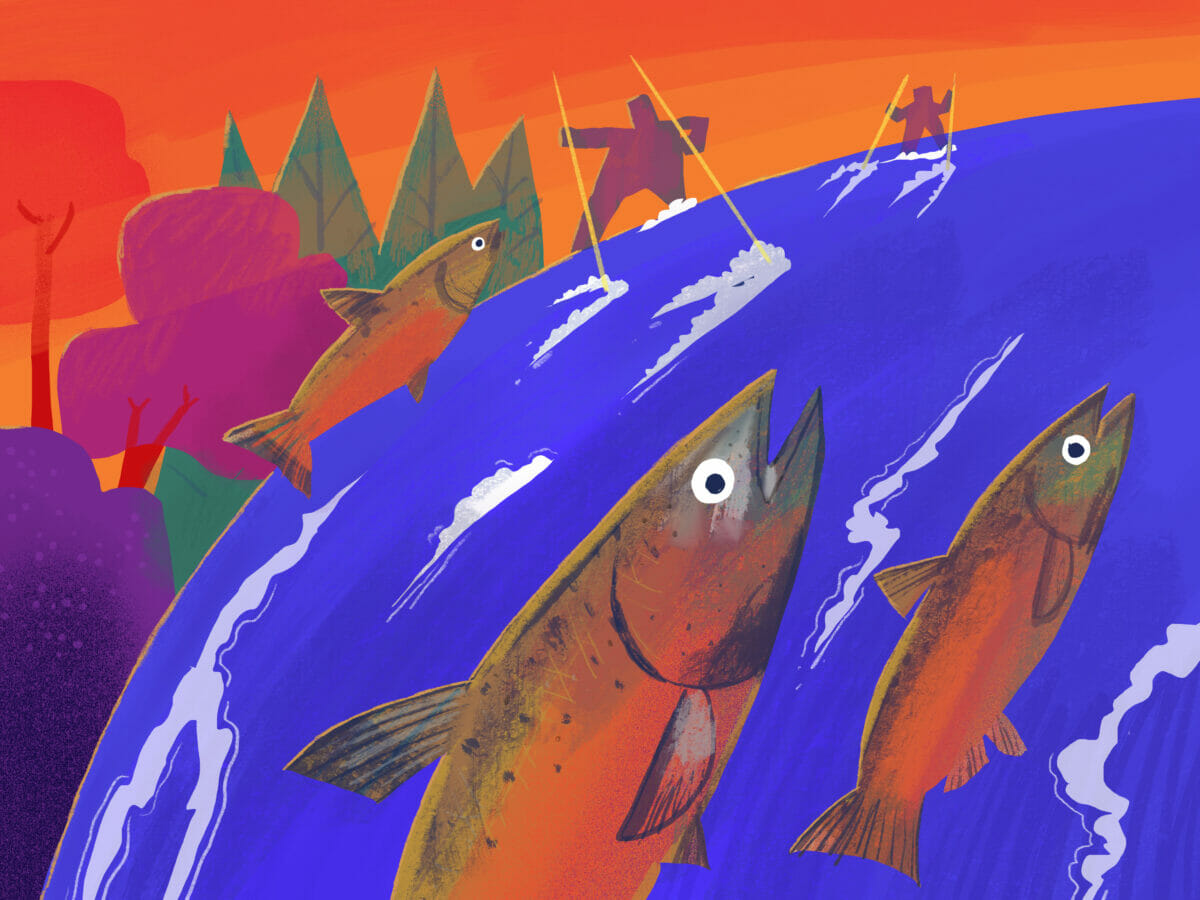
Arron Hockaday Sr. remembers fishing for salmon with his father in the late 1970s. Back then, it wasn’t just the number of salmon running up Northern California’s Klamath River that impressed him. It was the size.
“Back then, gosh, it was amazing to see the fish when the fish ran during the fall,” says Hockaday, a traditional fisherman and council member of the Karuk Tribe. “The salmon were huge.” On average, he says, you could catch fish ranging from 40 to 50 pounds—although members of his grandparents’ generation were known to catch 100-pound Chinook salmon at Ishi Pishi Falls, the tribe’s sacred fishing grounds. “Nowadays, our average is anywhere from 15 to maybe 25 pounds. We catch a 30-pounder and that’s a hog, that’s a big fish.”
A slow-motion disaster for tribes, commercial fishermen and conservationists, the decline of California’s once-abundant salmon population has been unfolding for decades. The crisis has its roots in decisions about the state’s water use made a century ago and, like so many stories of water wars in the West, it has pitted stakeholders against one another in a seemingly zero-sum contest over a dwindling natural resource.
The outlook is grim, but there are bright spots. As a future of increasingly hot and dry weather hangs over the state, can change come quickly enough to save the imperiled salmon from extinction?
Salmon are the epitome of endurance and resilience. Spawned in cold, high-elevation mountain streams, they navigate downriver as juveniles, fattening up as they make their way to coastal estuaries, where they undergo a remarkable transformation from freshwater to saltwater fish before entering the ocean. Depending on the species, they can spend years maturing at sea, where commercial fishermen vie for the valuable catch. Then, governed by an unshakeable biological imperative, they reverse the journey, this time propelling themselves against the current to return to their spawning grounds, where they’ll lay their eggs and then die, their nutrients enriching the river ecosystem.
Or, at least, that’s what salmon have historically done. But ever since white settlers made their way westward, a barrage of man-made challenges has disrupted the salmon’s natural journey. In the late 1840s came the gold miners, whose use of hydraulic mining clogged waterways with sediment. Then, a growing population began to reshape the state’s water systems, building channels and levees to control where water flowed. In the 20th century, ambitious dam projects rose up to store and divert water for cities and farming, cutting salmon off from hundreds of miles of upriver habitat.
“In a way, it’s amazing we have as many salmon around as we do,” says Peter Moyle, associate director of the Center for Watershed Sciences at the University of California, Davis and a distinguished professor emeritus in the university’s Department of Wildlife, Fish and Conservation Biology. He estimates that, prior to the Gold Rush, there were one million to two million salmon a year coming up through the Central Valley alone, and another half a million or more in other rivers. But a confluence of factors, including water diversions that erased more than 90 percent of the state’s wetlands and large dams that blocked 70 percent of salmon’s historic spawning grounds, have decimated the wild salmon population.
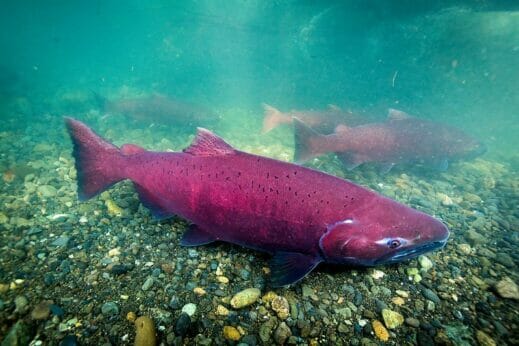
A mature Chinook salmon. (Photo: Ryan Hagerty/USFWS)
Today, the state’s salmon fishery is reliant on hatcheries that produce millions of fish and release them into the wild. “What we see today, the reason we have as much salmon as we do today, is hatcheries. But the hatchery fish are in decline,” says Moyle. “They keep producing more hatchery fish, and the numbers keep going down, partly because hatchery fish are poorly adapted for life in the wild.”
Warming waters present another threat, and one that increases in severity during drought, when surface water supplies falter. Warm freshwater can contribute to the proliferation of algal blooms and harmful bacteria, and temperatures above 70 degrees Fahrenheit can be lethal to salmon; ocean acidification and marine heatwaves also imperil the fish. That’s bad news for California, where, despite a winter of heavy rainfalls that refilled reservoirs and lifted the state out of a severe multi-year drought, human-caused climate change continues to accelerate the frequency and severity of extreme heat events and drought conditions.
And those recurrent drought conditions have forced salmon, and the people who rely on them, closer to a breaking point.
This spring, for just the second time in history, the ocean commercial and recreational salmon fishing season was canceled, impacting a swath of the West Coast, from northern Oregon to the border with Mexico. The decision came after last year’s Sacramento River fall-run Chinook, the principal salmon stock harvested in California’s fisheries, returned to the Central Valley at near-record low numbers—estimated at just 169,767 adults.
“Those numbers were abysmal,” says Glen Spain, executive director of the Pacific Coast Federation of Fishermen’s Associations. “What happens three years ago determines how many adults come back this year, so what we’re seeing was the worst part of the [2020] drought, which essentially dried up the rivers or created hot water conditions, and that just killed lots of eggs and lots of young salmon before they could even get to the ocean.”
Without the salmon season, many fishermen are losing their livelihoods. “There are over 1,000 boats out there with permits, and they’re basically in dry dock,” he says, noting that the closure could extend beyond this season, and up to another two years, creating uncertainty in an already challenging industry.
“It used to be that we could rely on a salmon season to buffer us from potentially a slow crab season,” says Dick Ogg, a commercial fisherman who operates out of Bodega Bay. “But with the seasons being compressed and getting smaller and smaller, and opportunities becoming less and less … the impact is significant.”
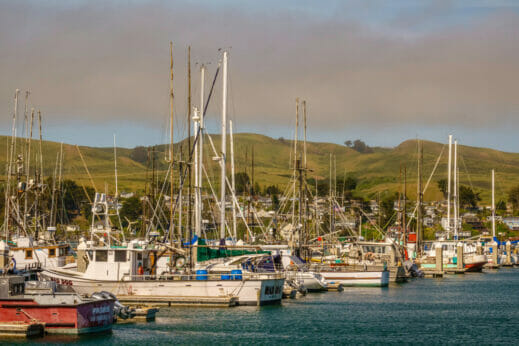
Fishing boats in Bodega Bay, CA. (Photo: Shutterstock)
In addition to salmon, Ogg holds permits to fish for black cod, albacore, Dungeness crab and rockfish. The days when a fisherman could rely on just the salmon fishery are “almost a thing of the past,” he says, but the cost of diversifying with multiple permits can become a barrier, especially for new fishermen entering the business. “The cost of each permit, the cost of owning your own vessel, the insurance that’s required, the slip fees that you have to pay, the taxes that you have to take care of, the crew that you need to maintain … it just is devastating.”
In April, California Governor Gavin Newsom submitted a request to the US Secretary of Commerce asking for a Federal Fishery Disaster Declaration, which would provide relief for businesses and fishermen impacted by the closure of the salmon season. In the meantime, Spain says, “There is the edge of desperation in a lot of our communities.”
“We all know why this is happening … but what we don’t know is how to get around it, at a family-by-family and port-by-port level,” says Spain. “And the sad thing is this was once a billion-dollar fishery.”
The formidable challenges facing California’s salmon population are prompting efforts to get creative with everything from building a controversial “fishway” around the Yuba River’s Daguerre Point Dam to exploring the reintroduction of fish transplanted to New Zealand more than a century ago, as the Winnemem Wintu Tribe has proposed.
In the Central Valley, one project has a particularly grand vision for transforming water management systems to support native fish. Called the Nigiri Project for its fish-on-rice concept, it’s a collaboration between researchers and farmers that floods rice fields in the winter, helping to break down rice straw while offering juvenile salmon and waterfowl conditions that mimic the bug-rich floodplain ecosystems to which they’re adapted.
It’s a win-win that researcher Jacob Katz hopes proves that a paradigm shift is possible. “We actually have the capacity to manage the Sacramento Valley in a way that is good for both fish and for farms,” says Katz, a senior scientist at California Trout, a nonprofit aimed at restoring waterways and wild fish. “One of the major reasons we’ve so diminished our fisheries resources is not necessarily an inevitable consequence of development but a specific and direct consequence of the way in which we developed.”
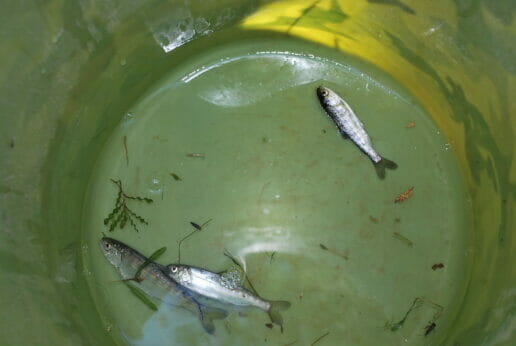
Juvenile Chinook salmon. (Photo: USFWS/Flickr)
Levees that block rivers from adjoining wetlands have benefits, such as flood protection and creating farmland, but they also cut fish off from essential food sources in floodplain wetlands, turning rivers into food deserts. The Nigiri Project, along with a related initiative that drains food-rich fields back into rivers, provides a blueprint for what Katz hopes could be a large-scale reimagining of the system. It’s ambitious, but Katz says that, “if you look at the science, we have no right to expect a population-level recovery of salmon if we aren’t actually changing the real world at landscape scale. To have a postage stamp here and a postage stamp there, why would we expect that to lead to population recovery? That’s not how it works.”
But rethinking the levee model to provide food for salmon would address just one of the two biggest problems facing the fish, says Katz. The other is the large-scale dam infrastructure that blocks salmon’s upstream migration. “The fact that we have essentially dammed all of the [Sacramento] Valley’s rivers, cutting off that critical cold water refuge, is ultimately a death sentence, an extinction sentence, for our salmon if something isn’t done.”
While most dams are built for a 50-year lifespan, the average age of California’s nearly 1,500 dams is 70 years old, according to the American Society of Civil Engineers, which gave the state’s dams a grade of C- in its most recent infrastructure report card. But that wasn’t what prompted the Klamath River tribal communities to launch a campaign to remove the four aging dams sitting upriver from them.
In 2002, upwards of 70,000 Chinook salmon died as part of a massive fish kill caused by low flows on the Klamath, the result of low flows caused by water diversions by farmers and ranchers upstream. “Tens of thousands of adult salmon died before spawning and just littered the banks of the river,” says Craig Tucker, a natural resource policy consultant for the Karuk Tribe. “And for tribal communities, that was sort of the breaking point.”
What followed was a grassroots effort by tribes and other advocacy groups to remove the dams, as well as to broker a water-sharing deal between the tribes and Klamath Basin irrigators that required an act of Congress to pass. Ultimately, the arduous, multi-decade campaign was successful: Demolition recently began on the first dam, and the remaining dams are set to come out by the end of 2024 in what’s been billed as the largest dam removal project in history.
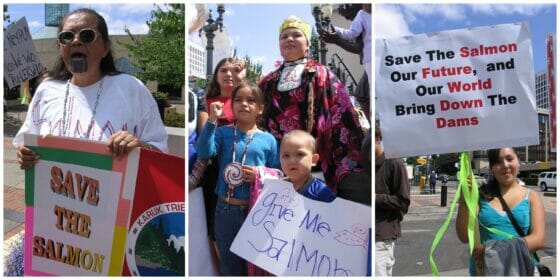
Klamath Basin tribes and allies staging a dam-removal rally in 2006. (Photo: Patrick McCully/Flickr)
“These should be easy,” says Tucker of the tortured process. “The Klamath River dams are what we call ‘deadbeat dams.’ They don’t pay their own way, there’s no flood control, no irrigation diversions, they’re not making a lot of money for anybody. They have this devastating impact on fisheries and water quality. It should be a no-brainer. And it’s taken us 20 years to get to dam removal.”
As most of the state’s dams are approaching or past their engineered life spans, Tucker says we’ve reached a critical inflection point for the future of salmon. “Now is that moment of reckoning: Are we going to have wild salmon or not? If we’re going to have wild salmon, we have to remove some dams.”
The situation reflects the complexity of a system that aims to control and deliver a limited resource—water—that just happens to also be the foundation of life on earth. For farmers, water is necessary for growing crops. For fishermen, it’s essential for supporting fish. And for the Karuk and other tribes, those fish form the basis of their entire cultural identity. “It’s not just a fish, it’s a way of life,” says Kenneth Brink, another Karuk council member and traditional fisherman. “It’s our ceremonies. It’s our cross on top of our church. Some people just look at fish as a food. Some people look at it as money. We look at it as a way of life.”
It remains to be seen whether that way of life—and the fish on which it relies—can continue. But for the people who are fighting for salmon’s survival, the only option is to carry on.
This story is part of State of Abundance, a five-part series about California agriculture and climate change. See the full series here.

My opinion is that the Salmon are declining in rivers due to low water levels. Look at the ways everyone talks about always one sided and not the big picture. This is caused by the climate change throughout the area. Then there is commercial fishing that doesn’t help much both play a big part in returning of the salmon. I would like more people to realize that it more than one party that creates these problems everyone needs to conserve the water in the river. The restrictions that were created in the nineteen eighties created more problems and not one… Read more »
If everyone thought like this (through such narrow vision) agriculture would cease and our entire global food system would collapse. Can you imagine? What then…?